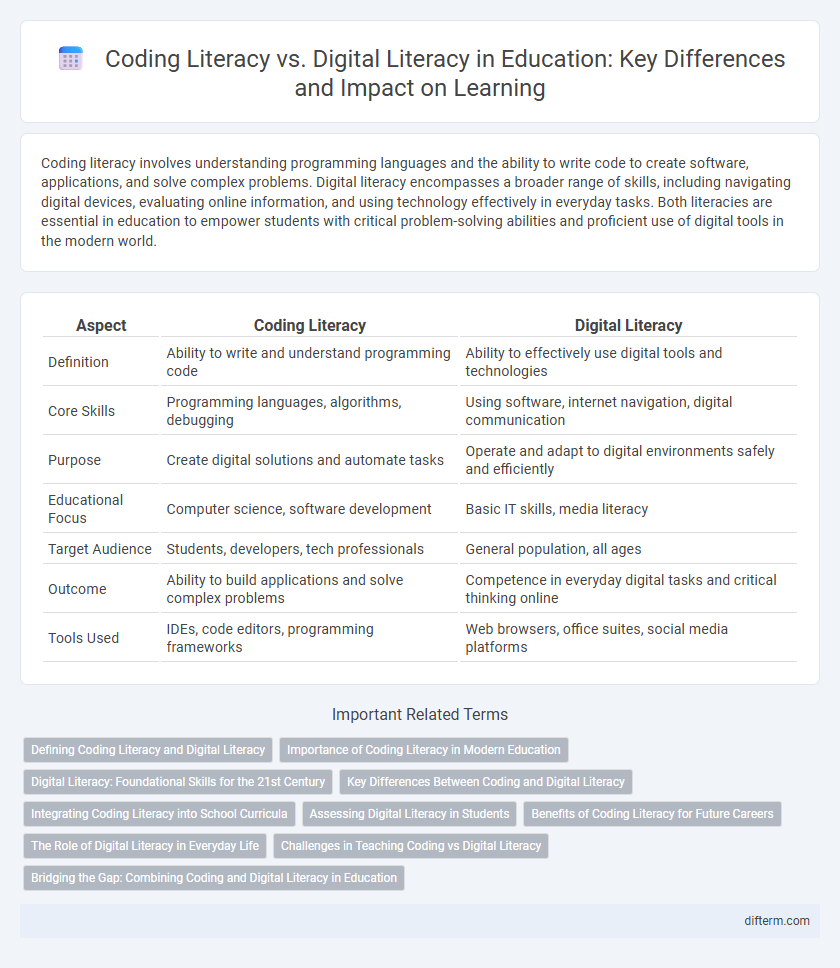Coding literacy involves understanding programming languages and the ability to write code to create software, applications, and solve complex problems. Digital literacy encompasses a broader range of skills, including navigating digital devices, evaluating online information, and using technology effectively in everyday tasks. Both literacies are essential in education to empower students with critical problem-solving abilities and proficient use of digital tools in the modern world.
Table of Comparison
| Aspect | Coding Literacy | Digital Literacy |
|---|---|---|
| Definition | Ability to write and understand programming code | Ability to effectively use digital tools and technologies |
| Core Skills | Programming languages, algorithms, debugging | Using software, internet navigation, digital communication |
| Purpose | Create digital solutions and automate tasks | Operate and adapt to digital environments safely and efficiently |
| Educational Focus | Computer science, software development | Basic IT skills, media literacy |
| Target Audience | Students, developers, tech professionals | General population, all ages |
| Outcome | Ability to build applications and solve complex problems | Competence in everyday digital tasks and critical thinking online |
| Tools Used | IDEs, code editors, programming frameworks | Web browsers, office suites, social media platforms |
Defining Coding Literacy and Digital Literacy
Coding literacy entails the ability to write, understand, and manipulate programming languages such as Python, JavaScript, or HTML to create software, websites, and applications. Digital literacy encompasses a broader skill set, including the proficient use of digital tools, online research, critical evaluation of digital content, and understanding digital safety and privacy. Mastering coding literacy enables individuals to develop technology, while digital literacy empowers them to effectively navigate and utilize digital environments.
Importance of Coding Literacy in Modern Education
Coding literacy equips students with problem-solving skills and logical thinking essential for today's technology-driven economy. Integrating coding into education fosters creativity and innovation, preparing learners for careers in software development, data analysis, and artificial intelligence. Emphasizing coding literacy complements digital literacy by enabling students to understand underlying technologies rather than just using digital tools.
Digital Literacy: Foundational Skills for the 21st Century
Digital literacy encompasses essential skills such as critical thinking, online communication, and understanding cybersecurity, forming the foundation for navigating today's technology-driven world. Unlike coding literacy, which focuses primarily on programming languages and software development, digital literacy equips individuals to effectively evaluate information, use digital tools responsibly, and adapt to rapidly evolving technologies. Mastering digital literacy is crucial for academic success, workplace efficiency, and active participation in modern society.
Key Differences Between Coding and Digital Literacy
Coding literacy involves understanding programming languages, algorithms, and the ability to create software or applications. Digital literacy encompasses broader skills such as navigating digital devices, evaluating online information, and practicing safe internet use. While coding literacy focuses on technical creation and problem-solving within digital environments, digital literacy emphasizes competent and responsible usage of digital tools and resources.
Integrating Coding Literacy into School Curricula
Integrating coding literacy into school curricula enhances students' problem-solving skills and prepares them for a technology-driven workforce, distinguishing it from broader digital literacy, which focuses on basic computer and internet navigation. Schools adopting coding programs report improved critical thinking and creativity, essential for future STEM careers. Embedding coding literacy complements digital literacy by fostering computational thinking, ensuring students are not only consumers of technology but also creators.
Assessing Digital Literacy in Students
Assessing digital literacy in students requires evaluating their ability to efficiently navigate, evaluate, and create digital content across various platforms and tools. Unlike coding literacy, which centers on programming skills and algorithmic thinking, digital literacy encompasses broader competencies such as online communication, information management, and critical media analysis. Effective assessment tools measure students' proficiency in using digital technologies safely, ethically, and productively within academic and real-world contexts.
Benefits of Coding Literacy for Future Careers
Coding literacy enhances problem-solving abilities and logical thinking, essential skills in the evolving technology-driven job market. Mastery of programming languages and algorithms equips individuals to create innovative software solutions, increasing employability across diverse industries like finance, healthcare, and artificial intelligence. Developing coding literacy fosters adaptability and technical proficiency, directly aligning with the demands of future careers in automation, data science, and computer engineering.
The Role of Digital Literacy in Everyday Life
Digital literacy involves understanding and effectively using digital tools and platforms for communication, information retrieval, and problem-solving in daily life. Coding literacy, while specialized in programming skills, is a subset of digital literacy that enhances one's ability to create and troubleshoot software applications. Digital literacy empowers individuals to navigate online environments safely, manage digital identities, and participate fully in modern society.
Challenges in Teaching Coding vs Digital Literacy
Teaching coding literacy presents challenges such as the need for specialized knowledge, complex problem-solving skills, and continuous updates to programming languages and tools. Digital literacy, while broader, requires educators to address diverse technologies, critical evaluation of online content, and the development of safe internet habits. Both disciplines face obstacles in resource availability, instructor training, and integrating curricula that keep pace with rapid technological advancements.
Bridging the Gap: Combining Coding and Digital Literacy in Education
Bridging the gap between coding literacy and digital literacy is essential for comprehensive education in the 21st century, equipping students with both the ability to understand programming languages and the skills to navigate digital tools safely and effectively. Integrating coding curricula with digital literacy programs fosters critical thinking, problem-solving, and responsible technology use, preparing learners for evolving career demands in STEM fields and beyond. This combined approach enhances cognitive flexibility, enabling students to create technology solutions while critically assessing digital information and cybersecurity issues.
Coding literacy vs Digital literacy Infographic

 difterm.com
difterm.com